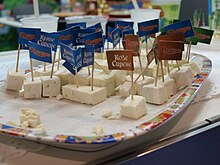Bjalo Salamureno siren
The Bjalo Salamureno siren ( бяло саламурено сирене ), often only as a siren ( сирене , sirɛnɛ ) and in the German-speaking world as Bulgarian feta cheese known is a popular and well-known brine cheese from Bulgaria , traditionally from sheep's milk is produced. The original production was done exclusively for the dairy farmers' own needs; With the increase in demand, however, it is now also produced industrially and also from cow's milk as Bjalo Salamureno Sirene ot krave mleko .
features
The Bjalo Salamureno Sirene is one of the most famous brine cheeses and sheep 's cheeses in the world , alongside the Greek feta and Turkish beyaz peynir 'white cheese' . As with these, it is a crumbly, firm white cheese without rind, with a smooth and firm cheese dough texture and without large holes. The consistency is reported as neither too hard nor too soft. It is manufactured in cuboid blocks with a typical edge length and width of 10 centimeters each and a height of 8 centimeters, but can also be offered in other sizes. It is in a milky white brine with a slightly sour taste and smell. The cheese itself is slightly salty and sour in taste.
The fat content in the dry matter of Bjalo Salamureno Sirene is at least 50% and on average a little higher (54 to 56%). Its dry mass itself must be at least 50% of the cheese mass. The average salt content in cheese is 4 to 6%, that of brine is 8 to 10%. It also contains 15 to 18% protein.
history

The Bjalo Salamureno Siren was only made in private households for self-sufficiency until the second half of the 19th century. It was not until the end of the 19th century that small seasonal farms, the mandri (singular: mandra), came into being, in which the cheese was also produced for national sales and export. In the 20th century, larger companies were set up to manufacture the siren. In 1957 cheese factories in Bulgaria produced more than 30,000 tons of cheese, of which the Sirene accounted for more than 27,500 tons. By the 1970s, production increased to over 70,000 tons of cheese, including more than 60,000 siren (made from sheep and cow milk). By 1974, the production of the real Bjalo Salamureno Sirene increased to such an extent that it represented around 75% of the sheep's milk cheese made in Bulgaria and 40% of the total cheese production.
Quality defect
Various errors can occur during the production of the cheese, which affect the quality of the cheese. A brine that is too salty, for example, can dry out the cheese and make it too hard. Contamination with bacteria, yeast and other fungi can lead to unpleasant changes in taste and smell. Treatment of animals with phenothiazines can lead to reddish discolouration of the milk and cheese.
use
The Bjalo Salamureno Sirene, like other brine cheeses, is mainly used for direct consumption. It is also used to prepare salads as well as other dishes and pasta.
supporting documents
- ^ A b c Patrick F. Fox: Cheese: Chemistry, Physics and Microbiology. Vol. 2: Major Cheese Groups. Springer Science + Media Business, 2nd edition, 2003; P. 275. ( Google Books )
- ↑ a b c d "Bjalo salamureno sirene" In: Heinrich Mair-Waldburg: Handbook of cheese. Cheese of the world from A – Z. An encyclopedia. Volkswirtschaftlicher Verlag, Kempten 1974; Pp. 303-305.
- ↑ a b "Bjalo Salamureno siren (Bulgarian white cheese made from sheep's milk)" In Gerhard Kielwein, Hans Kurt Luh: International Cheese customer. Seewald Verlag, Stuttgart 1979; Pp. 222-223. ISBN 3-512-00540-3 .
- ^ "Cheese of Bulgaria" In: Heinrich Mair-Waldburg: Handbook of cheese. Cheese of the world from A – Z. An encyclopedia. Volkswirtschaftlicher Verlag, Kempten 1974; Pp. 326-327.
